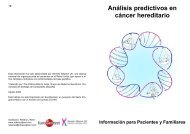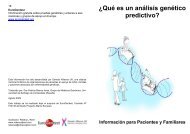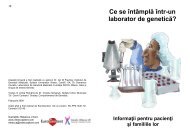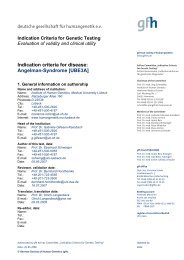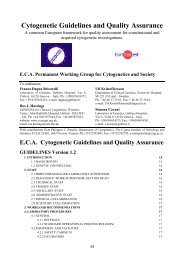Guidelines for molecular karyotyping in constitutional ... - EuroGentest
Guidelines for molecular karyotyping in constitutional ... - EuroGentest
Guidelines for molecular karyotyping in constitutional ... - EuroGentest
Create successful ePaper yourself
Turn your PDF publications into a flip-book with our unique Google optimized e-Paper software.
POLICY<br />
<strong>Guidel<strong>in</strong>es</strong> <strong>for</strong> <strong>molecular</strong> <strong>karyotyp<strong>in</strong>g</strong> <strong>in</strong><br />
<strong>constitutional</strong> genetic diagnosis<br />
Joris Robert Vermeesch* ,1 , Heike Fiegler 2 , Nicole de Leeuw 3 , Karoly Szuhai 4 ,<br />
Jacquel<strong>in</strong>e Schoumans 5 , Roberto Ciccone 6 , Frank Speleman 7 , Anita Rauch 8 ,<br />
Jill Clayton-Smith 9 , Conny Van Ravenswaaij 10 , Damien Sanlaville 11 ,<br />
Philippos C Patsalis 12 , Helen Firth 13 , Koen Devriendt 1 and Orsetta Zuffardi 6<br />
1 Center <strong>for</strong> Human Genetics, University Hospital Gasthuisberg, Leuven, Belgium; 2 The Wellcome Trust Sanger Institute,<br />
H<strong>in</strong>xton, Cambridgeshire, UK; 3 Department of Human Genetics, Nijmegen Centre <strong>for</strong> Molecular Life Sciences, Radboud<br />
University Nijmegen Medical Centre, Nijmegen, The Netherlands; 4 Department of Molecular Cell Biology, Leiden<br />
University Medical Centre, Leiden, The Netherlands; 5 Department of Molecular Medic<strong>in</strong>e and Surgery, Karol<strong>in</strong>ska<br />
Institute, Karol<strong>in</strong>ska University Hospital Solna, Stockholm, Sweden; 6 Biologia Generale e Genetica Medica, Università<br />
di Pavia, Pavia, Italy; 7 Center <strong>for</strong> Medical Genetics, Ghent University, Ghent, Belgium; 8 Institute of Human Genetics,<br />
Friedrich-Alexander University Erlangen-Nuremberg, Erlangen, Germany; 9 Academic Unit of Medical Genetics, St<br />
Mary’s Hospital, Manchester, UK; 10 Department of Genetics, University Medical Center, Gron<strong>in</strong>gen, The Netherlands;<br />
11 Cytogenetic Department, Hospices Civils de Lyon, Edouard Herriot Hospital, and Claude Bernard University, Lyon,<br />
France; 12 Department of Cytogenetics, The Cyprus Institute of Neurology and Genetics, Nicosia, Cyprus and<br />
13 Department of Cl<strong>in</strong>ical Genetics, Addenbrooke’s Hospital, Cambridge, UK<br />
Array-based whole genome <strong>in</strong>vestigation or <strong>molecular</strong> <strong>karyotyp<strong>in</strong>g</strong> enables the genome-wide detection of<br />
submicroscopic imbalances. Proof-of-pr<strong>in</strong>ciple experiments have demonstrated that <strong>molecular</strong><br />
<strong>karyotyp<strong>in</strong>g</strong> outper<strong>for</strong>ms conventional <strong>karyotyp<strong>in</strong>g</strong> with regard to detection of chromosomal imbalances.<br />
This article identifies areas <strong>for</strong> which the technology seems matured and areas that require more<br />
<strong>in</strong>vestigations. Molecular <strong>karyotyp<strong>in</strong>g</strong> should be part of the genetic diagnostic work-up of patients with<br />
developmental disorders. For the implementation of the technique <strong>for</strong> other <strong>constitutional</strong> <strong>in</strong>dications and<br />
<strong>in</strong> prenatal diagnosis, more research is appropriate. Also, the article aims to provide best practice<br />
guidel<strong>in</strong>es <strong>for</strong> the application of array comparative genomic hybridisation to ensure both technical and<br />
cl<strong>in</strong>ical quality criteria that will optimise and standardise results and reports <strong>in</strong> diagnostic laboratories. In<br />
short, both the specificity and the sensitivity of the arrays should be evaluated <strong>in</strong> every laboratory offer<strong>in</strong>g<br />
the diagnostic test. Internal and external quality control programmes are urgently needed to evaluate and<br />
standardise the test results between laboratories.<br />
European Journal of Human Genetics (2007) 15, 1105–1114; doi:10.1038/sj.ejhg.5201896; published onl<strong>in</strong>e 18 July 2007<br />
Keywords: best practice guidel<strong>in</strong>es; <strong>molecular</strong> karyotype; array CGH; copy number changes; genome-wide<br />
screen<strong>in</strong>g<br />
*Correspondence: Professor JR Vermeesch, Centre <strong>for</strong> Human Genetics,<br />
University Hospital Gasthuisberg, Herestraat 49, 3000 Leuven, Belgium.<br />
Tel: þ 32 16 345941; Fax: þ 32 16 346060;<br />
E-mail: Joris.Vermeesch@med.kuleuven.be<br />
Received 2 March 2007; revised 9 June 2007; accepted 15 June 2007;<br />
published onl<strong>in</strong>e 18 July 2007<br />
European Journal of Human Genetics (2007) 15, 1105–1114<br />
& 2007 Nature Publish<strong>in</strong>g Group All rights reserved 1018-4813/07 $30.00<br />
www.nature.com/ejhg<br />
Introduction<br />
Follow<strong>in</strong>g the discovery that humans carry 46 chromosomes<br />
and the association of different aneuploidies with<br />
specific phenotypes <strong>in</strong> the late 1950s, <strong>karyotyp<strong>in</strong>g</strong> was<br />
rapidly <strong>in</strong>troduced as a tool <strong>for</strong> the aetiological diagnosis of<br />
patients with mental retardation (MR) and birth defects. 1–5<br />
Initially, chromosome studies were per<strong>for</strong>med us<strong>in</strong>g simple
1106<br />
sta<strong>in</strong><strong>in</strong>g techniques which only allowed the detection of<br />
entire groups of chromosomes. The degree of precision was<br />
then <strong>in</strong>creased <strong>in</strong> the 1970s with the <strong>in</strong>troduction of<br />
chromosome band<strong>in</strong>g techniques. These techniques enabled<br />
the detection of <strong>in</strong>dividual chromosomes 6,7 and led<br />
to the identification of multiple syndromes associated with<br />
specific chromosomal imbalances. 8,9 Although chromosomal<br />
<strong>karyotyp<strong>in</strong>g</strong> allows a genome-wide detection of large<br />
chromosomal abnormalities and translocations, it has a<br />
number of <strong>in</strong>herent limitations: (1) it takes between 4 and<br />
10 days to culture the cells, visualise chromosomes and<br />
per<strong>for</strong>m the analysis; (2) the resolution of a karyotype is<br />
limited to 5–10 Mb depend<strong>in</strong>g on (i) the location <strong>in</strong> the<br />
genome, (ii) the quality of the chromosome preparation and<br />
(iii) the skill and experience of the cytogeneticist; and (3) it<br />
requires skilled technicians to per<strong>for</strong>m a Giemsa-banded<br />
karyotype analysis, which <strong>in</strong>creases employment costs and<br />
can lead to organisational difficulties <strong>in</strong> small laboratories.<br />
With the <strong>in</strong>troduction of fluorescence <strong>in</strong> situ hybridisation<br />
(FISH) the detection of submicroscopic chromosomal<br />
imbalances became possible. In FISH, labelled DNA probes<br />
are hybridised to nuclei or metaphase chromosomes to<br />
detect the presence, number and location of small (submicroscopic)<br />
regions of chromosomes. FISH is rout<strong>in</strong>ely<br />
used to identify, confirm and characterise chromosomal<br />
abnormalities or confirm the cl<strong>in</strong>ical suspicion of known<br />
microdeletion syndromes. 10 Also, more recently, other<br />
<strong>molecular</strong> methods, such as quantitative PCR (Q-PCR)<br />
and multiplex ligation-dependent probe amplification<br />
(MLPA), have been developed to detect accurately submicroscopic<br />
copy number variations (CNVs) with the<br />
possibility to <strong>in</strong>terrogate multiple targets with<strong>in</strong> one<br />
experiment (reviewed by Sellner and Taylor 11 ). However,<br />
all these methods are targeted and can only screen<br />
<strong>in</strong>dividual DNA targets rather than the entire genome.<br />
To overcome this problem, multicolour FISH-based<br />
<strong>karyotyp<strong>in</strong>g</strong> (SKY, MFISH and COBRA FISH) was developed,<br />
which enables simultaneous detection of all chromosomes.<br />
10,12,13 Another technology allow<strong>in</strong>g the genomewide<br />
detection of copy number aberrations was <strong>in</strong>troduced<br />
<strong>in</strong> 1992 and termed comparative genomic hybridisation<br />
(CGH). 14 In CGH, test and reference genomic DNAs are<br />
differentially labelled with fluorochromes and then cohybridised<br />
onto normal metaphase chromosomes. Follow<strong>in</strong>g<br />
hybridisation, the chromosomes are scanned to<br />
measure the fluorescence <strong>in</strong>tensities along the length of<br />
the normal chromosomes to detect <strong>in</strong>tensity ratio differences<br />
that subsequently p<strong>in</strong>po<strong>in</strong>t to genomic imbalances.<br />
Overall, the resolution at which copy number changes can<br />
be detected us<strong>in</strong>g these techniques are only slightly higher<br />
as compared to conventional <strong>karyotyp<strong>in</strong>g</strong> (43 Mb) and all<br />
experiments are labour <strong>in</strong>tensive and time consum<strong>in</strong>g.<br />
By replac<strong>in</strong>g metaphase chromosomes with mapped<br />
DNA sequences or oligonucleotides arrayed onto glass<br />
slides as the hybridisation targets, these limitations could<br />
European Journal of Human Genetics<br />
Array CGH guidel<strong>in</strong>es<br />
JR Vermeesch et al<br />
be overcome. Follow<strong>in</strong>g hybridisation of differentially<br />
labelled test and reference genomic DNAs to the target<br />
sequences on the microarray, the slide is scanned to<br />
measure the fluorescence <strong>in</strong>tensities at each target on the<br />
array. The normalised fluorescent ratio <strong>for</strong> the test and<br />
reference DNAs is then plotted aga<strong>in</strong>st the position of the<br />
sequence along the chromosomes. Ga<strong>in</strong>s or losses across<br />
the genome are identified by values <strong>in</strong>creased or decreased<br />
from a 1:1 ratio (log2 value of 0), and the detection<br />
resolution now only depends on the size and the number<br />
of targets on an array and the position of these targets<br />
(their distribution) on the genome. This methodology was<br />
first described <strong>in</strong> 1997 and is termed matrix or array<br />
CGH. 15,16 Array CGH has <strong>in</strong>itially been employed to<br />
analyse copy number changes <strong>in</strong> tumours with the aim<br />
to identify genes <strong>in</strong>volved <strong>in</strong> the pathogenesis of cancers.<br />
17,18 More recently, however, this methodology has<br />
been optimised and applied to detect unbalanced <strong>constitutional</strong><br />
rearrangements. 19,20<br />
Genome-wide screen<strong>in</strong>g <strong>for</strong> CNVs <strong>in</strong> a cl<strong>in</strong>ical genetic<br />
context at a def<strong>in</strong>ed high resolution has been termed<br />
<strong>molecular</strong> <strong>karyotyp<strong>in</strong>g</strong> and <strong>in</strong>cludes technologies such as<br />
array CGH or hybridisation methods <strong>in</strong> which control and<br />
sample are hybridised separately. 21,22 Several studies have<br />
demonstrated the potential value of genomic arrays <strong>in</strong> the<br />
diagnosis of thus far unexpla<strong>in</strong>ed developmental/MR<br />
disorders. It has been proposed that <strong>in</strong> analogy with the<br />
<strong>in</strong>troduction of chromosome <strong>karyotyp<strong>in</strong>g</strong> <strong>in</strong> the early<br />
1960s, genomic arrays should now be implemented as a<br />
genetic diagnostic service and several genetic centres<br />
already offer <strong>molecular</strong> <strong>karyotyp<strong>in</strong>g</strong> to patients. 23,24 However,<br />
the <strong>in</strong>troduction of <strong>molecular</strong> <strong>karyotyp<strong>in</strong>g</strong> <strong>in</strong> genetic<br />
services raises many cl<strong>in</strong>ical as well as technical questions:<br />
<strong>for</strong> which disorders is the test useful? What is the cl<strong>in</strong>ical<br />
sett<strong>in</strong>g <strong>in</strong> which the tests should be requested, per<strong>for</strong>med<br />
and <strong>in</strong>terpreted? What are the positive and negative<br />
predictive values? What are the genotype/phenotype<br />
relationships? Consider<strong>in</strong>g that <strong>molecular</strong> <strong>karyotyp<strong>in</strong>g</strong><br />
can be per<strong>for</strong>med <strong>in</strong> different ways, us<strong>in</strong>g different array<br />
plat<strong>for</strong>ms and software, the outcome of a genomic array<br />
experiment on patient DNA may be very different <strong>in</strong><br />
different laboratories or even with<strong>in</strong> a s<strong>in</strong>gle laboratory.<br />
Hence, there is a need to def<strong>in</strong>e quality standards as well as<br />
guidel<strong>in</strong>es <strong>for</strong> patient reports. This article aims to address<br />
the cl<strong>in</strong>ical utility and validity of <strong>molecular</strong> <strong>karyotyp<strong>in</strong>g</strong><br />
and provides a framework on how to <strong>in</strong>troduce the array<br />
technology <strong>in</strong> cl<strong>in</strong>ical genetics (ACCE; http://www.cdc.gov/<br />
genomics/gtest<strong>in</strong>g/ACCE.htm, Burke et al, 2002 25 ).<br />
Cl<strong>in</strong>ical utility<br />
Postnatal diagnosis of developmental delay/MR<br />
and/or congenital anomalies<br />
MR with or without congenital mal<strong>for</strong>mations occurs <strong>in</strong><br />
B3% of the population and is aetiologically hetero-
geneous. 26 Chromosomal anomalies as detected by conventional<br />
<strong>karyotyp<strong>in</strong>g</strong> are one of the most common recognised<br />
causes, account<strong>in</strong>g <strong>for</strong> an estimated 10% of MR. 27 In about<br />
50% of patients with MR, the aetiology rema<strong>in</strong>s unknown.<br />
Nevertheless, an aetiological diagnosis is important <strong>for</strong><br />
many reasons. A precise diagnosis may, <strong>for</strong> example, lead<br />
to prevention or even an earlier detection of some<br />
pathogenic signs (eg obesity <strong>in</strong> Prader–Willi patients,<br />
Wilms tumour <strong>in</strong> Wilms tumour, aniridia, genitour<strong>in</strong>ary<br />
anomalies mental retardation (WAGR) syndrome) or may<br />
enable improved medical care <strong>for</strong> the <strong>in</strong>dividual (eg<br />
echocardiogram if a gene implicated <strong>in</strong> congenital heart<br />
disease is <strong>in</strong>volved). Moreover, a diagnosis often is essential<br />
<strong>for</strong> genetic counsell<strong>in</strong>g and reproductive choices of the<br />
<strong>in</strong>dividual and his/her family. For parents, <strong>in</strong>sight <strong>in</strong> the<br />
cause of a handicap will lead to reduced uncerta<strong>in</strong>ty and<br />
may alleviate feel<strong>in</strong>gs of guilt. 28 S<strong>in</strong>ce <strong>in</strong> 50% of patients<br />
no aetiological diagnosis can be made, 29 families may seek<br />
advice from several specialised physicians and undergo<br />
multiple diagnostic tests. This leads to a ‘diagnostic<br />
odyssey’ of often repeated test<strong>in</strong>g <strong>for</strong> many different<br />
conditions. 23 An early diagnosis will avoid the anxiety<br />
and stra<strong>in</strong> put on a patient and his family by the current<br />
procedures. These frequently <strong>in</strong>volve multiple hospital<br />
appo<strong>in</strong>tments and repeated and often <strong>in</strong>vasive <strong>in</strong>vestigations,<br />
some of which (eg magnetic resonance imag<strong>in</strong>g<br />
under sedation) are not entirely risk-free.<br />
Several studies have demonstrated the efficacy of arraybased<br />
methods to detect apparent pathogenic imbalances<br />
<strong>in</strong> both children and adults with MR and multiple<br />
congenital anomalies (MCA), but normal conventional<br />
cytogenetic analyses. These studies have been per<strong>for</strong>med<br />
us<strong>in</strong>g plat<strong>for</strong>ms of <strong>in</strong>creas<strong>in</strong>g resolution. The first reports<br />
described the application of chromosome-specific arrays 30<br />
and large <strong>in</strong>sert clone arrays cover<strong>in</strong>g the entire human<br />
genome at 1 Mb, 19,20,24,31,32 or more; recently, full-til<strong>in</strong>g<br />
path resolution. 33 In addition, oligo-based array plat<strong>for</strong>ms<br />
are now be<strong>in</strong>g <strong>in</strong>creas<strong>in</strong>gly applied <strong>in</strong> these studies. 23<br />
While a comparison of the detection rate of pathogenic<br />
imbalances <strong>in</strong> these studies is confounded by different<br />
patient selection criteria, overall 7–11% of patients were<br />
diagnosed with cryptic pathogenic submicroscopic chromosomal<br />
imbalances. In addition, <strong>in</strong> patient cohorts that<br />
have not previously screened <strong>for</strong> subtelomeric imbalances,<br />
about 5% of subtelomeric imbalances are detected. This<br />
number is roughly <strong>in</strong> concordance with the numerous<br />
reports on subtelomeric screens <strong>in</strong> these types of patient<br />
cohorts. 34 The detection rate of pathogenic imbalances<br />
appears to <strong>in</strong>crease slightly by us<strong>in</strong>g higher resolution<br />
arrays. High-resolution screens of MCA/MR patients with<br />
MCA/MR us<strong>in</strong>g either full-til<strong>in</strong>g large <strong>in</strong>sert clone or oligo<br />
arrays found that 20% of all detected imbalances were<br />
smaller than 1 Mb, <strong>in</strong>dicat<strong>in</strong>g that higher resolutions<br />
screens will improve the diagnostic yield, but also add<br />
complexity due to the need to differentiate pathogenic<br />
Array CGH guidel<strong>in</strong>es<br />
JR Vermeesch et al<br />
from normal CNV at this level of resolution. 23,33 Thus, with<br />
regard to the diagnosis of unexpla<strong>in</strong>ed MCA/MR, the<br />
criteria of cl<strong>in</strong>ical utility <strong>for</strong> <strong>molecular</strong> <strong>karyotyp<strong>in</strong>g</strong> <strong>in</strong> this<br />
specific sett<strong>in</strong>g certa<strong>in</strong>ly is fulfilled. General experience<br />
suggests to request this <strong>in</strong>vestigation with the same criteria<br />
used to request cytogenetic <strong>in</strong>vestigations.<br />
In addition to the diagnosis of patients without visible<br />
chromosomal anomalies, <strong>molecular</strong> <strong>karyotyp<strong>in</strong>g</strong> can also<br />
reveal unsuspected imbalances <strong>in</strong> patients with visible<br />
chromosomal imbalances. In particular, apparently balanced<br />
translocations <strong>in</strong> patients with abnormal phenotypes<br />
may hide deletions both at the breakpo<strong>in</strong>t and<br />
elsewhere <strong>in</strong> the genome. 35,36 Prelim<strong>in</strong>ary data demonstrated<br />
that other rearrangements also, such as r<strong>in</strong>g<br />
chromosomes, may be more complex than anticipated 37<br />
(Rossi et al, submitted). Hence, it is advised to <strong>in</strong>vestigate<br />
these rearrangements through whole-genome arrays.<br />
Prenatal diagnosis<br />
In analogy with conventional prenatal <strong>karyotyp<strong>in</strong>g</strong>, it is<br />
tempt<strong>in</strong>g to <strong>in</strong>troduce <strong>molecular</strong> <strong>karyotyp<strong>in</strong>g</strong> <strong>in</strong> a prenatal<br />
sett<strong>in</strong>g. The key issues are the speed (no cultur<strong>in</strong>g is<br />
required and automation of certa<strong>in</strong> steps <strong>in</strong> the procedure<br />
is possible) and the higher resolution with <strong>molecular</strong><br />
compared to conventional <strong>karyotyp<strong>in</strong>g</strong>. A number of<br />
proof-of-pr<strong>in</strong>ciple cl<strong>in</strong>ical studies are currently ongo<strong>in</strong>g.<br />
38 – 41 However, there are a number of potential<br />
pitfalls that have to be avoided.<br />
Most prenatal test<strong>in</strong>g is carried out <strong>in</strong> the context of<br />
advanced maternal age or <strong>in</strong>creased risk <strong>for</strong> Down<br />
syndrome based on ultrasound tests or serum markers. In<br />
this context, many laboratories have already moved from<br />
conventional <strong>karyotyp<strong>in</strong>g</strong> towards MLPA, Q-PCR or <strong>in</strong>terphase<br />
FISH, either directed at detect<strong>in</strong>g only trisomy 21 or<br />
<strong>in</strong> comb<strong>in</strong>ation with detection of aneuploidies <strong>for</strong> chromosomes<br />
13, 18, X and Y. However, <strong>in</strong> contrast to<br />
conventional <strong>karyotyp<strong>in</strong>g</strong> or FISH analysis <strong>for</strong> established<br />
loci, genome-wide array analysis <strong>in</strong>terrogates the entire<br />
genome. Array CGH will obviously detect any of those<br />
whole-chromosome alterations with the possibility to<br />
detect mosaic alterations (see later sections). In addition<br />
to the detection of imbalances result<strong>in</strong>g <strong>in</strong> well-established<br />
developmental disorders, <strong>molecular</strong> <strong>karyotyp<strong>in</strong>g</strong> will detect<br />
imbalances <strong>in</strong> regions <strong>for</strong> which we do not know the<br />
phenotypic consequences yet. Although benign DNA copy<br />
number variants are currently be<strong>in</strong>g <strong>in</strong>ventorised, assessment<br />
of their cl<strong>in</strong>ical relevance requires further study. Also,<br />
<strong>for</strong> each new imbalance that has not been reported<br />
previously, phenotypic consequences and penetrance<br />
may be difficult to predict <strong>in</strong> the absence of extensive<br />
family data and genotyope/phenotype correlations. It is<br />
difficult to envisage how this specific sett<strong>in</strong>g could benefit<br />
from the <strong>in</strong>troduction of <strong>molecular</strong> <strong>karyotyp<strong>in</strong>g</strong>, particularly<br />
with regard to its <strong>in</strong>creased resolution and thus the<br />
potential to detect imbalances that at present cannot be<br />
1107<br />
European Journal of Human Genetics
1108<br />
<strong>in</strong>terpreted. A possible solution to this problem might be<br />
the development of arrays with a limited number of wellknown<br />
targets.<br />
In the case of prenatal <strong>karyotyp<strong>in</strong>g</strong> follow<strong>in</strong>g the<br />
detection of mal<strong>for</strong>mations on ultrasound exam<strong>in</strong>ations,<br />
the a priori chance to detect a causal aberration is much<br />
higher, and especially <strong>in</strong> the presence of specific phenotypic<br />
anomalies, the <strong>in</strong>terpretation of an abnormal result<br />
may be facilitated by the <strong>molecular</strong> analyses. Potentially,<br />
more extensive pre- and post-test<strong>in</strong>g counsell<strong>in</strong>g will be<br />
needed to ensure that imbalances which cannot be<br />
<strong>in</strong>terpreted are not perceived as true anomalies by parents<br />
and physicians. However, cl<strong>in</strong>ical geneticists are already<br />
familiar with this problem when fac<strong>in</strong>g most of counsell<strong>in</strong>g<br />
cases with de novo supernumerary marker chromosomes<br />
or de novo apparently balanced translocations.<br />
Carefully designed cl<strong>in</strong>ical studies, <strong>in</strong>itially <strong>in</strong> a research<br />
context, are warranted to establish practical guidel<strong>in</strong>es.<br />
A de novo apparently balanced chromosome rearrangement<br />
is associated with a 6.7% risk of a congenital anomaly<br />
<strong>in</strong> the child, some of which will be related to a submicroscopic<br />
imbalance. 42 Currently it is not clear what percentage<br />
of these children do harbour submicroscopic<br />
imbalances, and <strong>molecular</strong> <strong>karyotyp<strong>in</strong>g</strong> may aid <strong>in</strong> the<br />
unmask<strong>in</strong>g of these translocation-associated imbalances.<br />
35,36,42 Further research <strong>in</strong> this area is strongly<br />
recommended. Likewise <strong>for</strong> extra structurally abnormal<br />
chromosomes, <strong>molecular</strong> <strong>karyotyp<strong>in</strong>g</strong> has the potential to<br />
determ<strong>in</strong>e the size and the presence of euchromatic regions<br />
more precisely. However, as <strong>for</strong> other chromosomal<br />
imbalances, currently genotype/phenotype data on small,<br />
supernumerary marker chromosomes are not sufficient to<br />
allow accurate <strong>in</strong>terpretation <strong>in</strong> all <strong>in</strong>stances. 43 Hence, <strong>in</strong><br />
this area also more research is needed.<br />
Infertility and recurrent abortion<br />
While <strong>molecular</strong> <strong>karyotyp<strong>in</strong>g</strong> can reveal imbalances <strong>in</strong> the<br />
genome, to date it cannot detect balanced rearrangements<br />
without the separation of the derivative chromosomes<br />
44 – 46<br />
away from the rest of the genome be<strong>for</strong>e the analysis<br />
Fa procedure that is not easily amenable <strong>in</strong> a diagnostic<br />
sett<strong>in</strong>g. S<strong>in</strong>ce chromosomal translocations are a significant<br />
cause of <strong>in</strong>fertility, conventional <strong>karyotyp<strong>in</strong>g</strong> rema<strong>in</strong>s the<br />
key diagnostic test <strong>for</strong> this <strong>in</strong>dication. Recurrent miscarriages<br />
are often caused by the unbalanced transmission of a<br />
chromosomal translocation <strong>in</strong> one of the parents. Subtelomeric<br />
analysis us<strong>in</strong>g FISH may also be used to<br />
<strong>in</strong>vestigate <strong>for</strong> the presence of cryptic translocations<br />
although only 1 <strong>in</strong> 50 couples with repeated abortions<br />
had been reported harbour<strong>in</strong>g such a rearrangement, 47 and<br />
only one among 29 parents carry<strong>in</strong>g a cryptic translocation<br />
ascerta<strong>in</strong>ed through an unbalanced proband had repeated<br />
abortions. 34<br />
European Journal of Human Genetics<br />
Array CGH guidel<strong>in</strong>es<br />
JR Vermeesch et al<br />
Miscarriages<br />
To determ<strong>in</strong>e whether an abortion is caused by a genetic<br />
defect, fibroblasts derived from the sk<strong>in</strong> of spontaneously<br />
aborted foetuses are, <strong>in</strong> some countries rout<strong>in</strong>ely, karyotyped.<br />
The f<strong>in</strong>d<strong>in</strong>g of a chromosomal rearrangement may<br />
highlight the presence of a predispos<strong>in</strong>g situation <strong>in</strong> one of<br />
the parents, and the f<strong>in</strong>d<strong>in</strong>g of an aneuploidy may con<strong>for</strong>t<br />
the parents as recurrence risk is low. Several <strong>molecular</strong><br />
<strong>karyotyp<strong>in</strong>g</strong> studies on aborted foetuses have detected<br />
submicroscopic imbalances. 48 – 50 As <strong>for</strong> postnatal diagnosis,<br />
<strong>molecular</strong> <strong>karyotyp<strong>in</strong>g</strong> may complement or replace the<br />
current rout<strong>in</strong>e analyses, particularly <strong>for</strong> those aborted<br />
foetuses with normal karyotype. Further research <strong>in</strong> this<br />
area is required.<br />
Mosaicism detection<br />
When a chromosomal mosaicism is suspected, cultured<br />
fibrobasts are karyotyped. It seems likely that <strong>molecular</strong><br />
<strong>karyotyp<strong>in</strong>g</strong> will enable the detection of such mosaicisms.<br />
Further research to confirm that <strong>molecular</strong> <strong>karyotyp<strong>in</strong>g</strong><br />
enables the detection of such mosaics is required.<br />
Analytical validity<br />
Analytical validity deals with the technical aspects of<br />
<strong>molecular</strong> <strong>karyotyp<strong>in</strong>g</strong>, that is, the accuracy of a test to<br />
detect a chromosomal aberration. Array CGH <strong>in</strong>terrogates<br />
thousands of loci <strong>in</strong> a s<strong>in</strong>gle experiment. The challenge of<br />
an array CGH experiment <strong>in</strong> a cl<strong>in</strong>ical sett<strong>in</strong>g is to call all<br />
targets without call<strong>in</strong>g either false positives or false<br />
negatives. Specificity is def<strong>in</strong>ed as the probability of a<br />
negative test among patients without disease (those who<br />
do not have any chromosomal imbalance), whereas the<br />
sensitivity measures the effectiveness of a test to detect a<br />
chromosomal imbalance. The ability to detect a chromosomal<br />
imbalance depends on the resolution of the array<br />
used. To obta<strong>in</strong> high sensitivity and specificity levels,<br />
adequate plat<strong>for</strong>ms and adequate threshold algorithms are<br />
required, false positive as well as false negative rates have to<br />
be determ<strong>in</strong>ed, and the achievable resolution of the array<br />
needs to be established experimentally.<br />
Specificity and sensitivity<br />
To validate the optimal thresholds and to establish the false<br />
positive and the false negative rates of array results <strong>in</strong> any<br />
laboratory sett<strong>in</strong>g, a series of experiments <strong>in</strong>clud<strong>in</strong>g self–<br />
self hybridisations, replicate experiments, gender mismatch<br />
analyses, hybridisations us<strong>in</strong>g DNA with established<br />
copy number changes and chromosome add-<strong>in</strong> experiments<br />
should be per<strong>for</strong>med. For example, copy number<br />
changes by def<strong>in</strong>ition cannot exist <strong>in</strong> self–self-hybridisations,<br />
there<strong>for</strong>e none of the clones present on the array<br />
should report a copy number change. In practice, however,<br />
a small number of false calls or flagged reporters (excluded<br />
from further data process<strong>in</strong>g) will always be made due to
labell<strong>in</strong>g bias and hybridisation artefacts. To determ<strong>in</strong>e<br />
false positive/false negative call<strong>in</strong>g rates and reproducibility,<br />
replicate experiments should be per<strong>for</strong>med so that<br />
appropriate threshold algorithms can be established m<strong>in</strong>imis<strong>in</strong>g<br />
false positive/false negative calls. In addition,<br />
gender mismatch or hybridisations us<strong>in</strong>g DNA with<br />
established copy number changes, <strong>for</strong> example DNA<br />
derived from a patient with regular trisomy 21, can support<br />
the determ<strong>in</strong>ation of false positive/false negative rates <strong>for</strong><br />
that given chromosome-related clones. There<strong>for</strong>e the best<br />
option would be the use of chromosome-specific add-<strong>in</strong><br />
samples to validate the hybridisation characteristics of all<br />
clones represent<strong>in</strong>g the respective chromosomes. 51 Un<strong>for</strong>tunately,<br />
such add-<strong>in</strong> samples are not yet commercially<br />
available.<br />
While the appearance of a number of consecutive clones<br />
with deviat<strong>in</strong>g ratios is highly likely to reflect a true copy<br />
number change <strong>in</strong> a patient’s genome, s<strong>in</strong>gle clone calls are<br />
difficult to <strong>in</strong>terpret. We there<strong>for</strong>e suggest <strong>in</strong>clud<strong>in</strong>g <strong>in</strong><br />
each array analysis multiple measurements <strong>for</strong> every target<br />
on the array. This could be achieved by either per<strong>for</strong>m<strong>in</strong>g<br />
replicate (dye-swap) experiments, or provid<strong>in</strong>g multiple<br />
copies of the same target/redundant targets on the array.<br />
Dependent on the probability that an imbalance is causal,<br />
follow-up control experiments on the patient and their<br />
parents should be per<strong>for</strong>med whenever appropriate. When<br />
multiple clones with<strong>in</strong> the same region report a deviation<br />
from the expected ratio, the probability that this deviation<br />
represents a real imbalance <strong>in</strong>creases. If, on the other hand,<br />
only a s<strong>in</strong>gle target deviates from the expected ratio, this<br />
probability decreases. S<strong>in</strong>ce probability values will depend<br />
on the array quality, the number and the sizes of the targets<br />
on an array and <strong>in</strong> general wet-lab experimental conditions,<br />
these probabilities have to be established <strong>in</strong> each<br />
laboratory. This probability can experimentally be established<br />
by follow-up validation experiments on a large series<br />
of potential imbalances.<br />
In array CGH, DNA from a patient is hybridised aga<strong>in</strong>st<br />
reference control DNA. Different sources of reference DNAs<br />
have been used to detect imbalances <strong>in</strong> patients <strong>in</strong>clud<strong>in</strong>g<br />
DNA from a well-established cell l<strong>in</strong>e, DNA from a wellcharacterised<br />
reference <strong>in</strong>dividual or DNA pooled from a<br />
cohort of ‘normal’ <strong>in</strong>dividuals. Another approach, avoid<strong>in</strong>g<br />
the need <strong>for</strong> a specific reference DNA, is the so-called<br />
loop hybridisation: DNA from one patient is hybridised<br />
aga<strong>in</strong>st DNA from two other patients. 24 In this approach it<br />
is essential to ensure that all three patients are diagnosed<br />
with different phenotypes and do not carry the same<br />
imbalance. The choice of the reference DNA is crucial to<br />
attribute an imbalance to the reference or to the patient.<br />
Possible solutions <strong>in</strong>clude replicat<strong>in</strong>g the experiment with<br />
another reference DNA or use of a very well characterised<br />
reference DNA. The development of validated <strong>in</strong>ternational<br />
control samples may be beneficial. However, it<br />
should be realised that the importance of reference DNA<br />
Array CGH guidel<strong>in</strong>es<br />
JR Vermeesch et al<br />
sample is less relevant by us<strong>in</strong>g an SNP array-based<br />
approach.<br />
We suggest establish<strong>in</strong>g an <strong>in</strong>ternal quality control<br />
programme to address these po<strong>in</strong>ts. Furthermore, if ‘<strong>in</strong>house’<br />
produced arrays are used <strong>for</strong> diagnostic purposes, we<br />
recommend determ<strong>in</strong><strong>in</strong>g the quality of each pr<strong>in</strong>ted batch<br />
of arrays. This can be per<strong>for</strong>med by hybridis<strong>in</strong>g a set<br />
number of slides (typically the first and the last) from each<br />
batch with patient DNA conta<strong>in</strong><strong>in</strong>g known aberrations. We<br />
strongly advise to per<strong>for</strong>m a similar QA programme <strong>for</strong><br />
commercially available arrays.<br />
Resolution<br />
The resolution of <strong>molecular</strong> <strong>karyotyp<strong>in</strong>g</strong> is <strong>in</strong> the first<br />
<strong>in</strong>stance dependent on the plat<strong>for</strong>m used. The higher the<br />
number of targets, the higher the potential resolution will<br />
be. However, the effective resolution will typically be lower<br />
because (1) the values of successive targets are often<br />
averaged and (2) the average spac<strong>in</strong>g of targets and<br />
m<strong>in</strong>imum/maximum coverage of specific regions is variable.<br />
Based on the previously discussed control hybridisations<br />
us<strong>in</strong>g reference samples with DNA imbalances of variable<br />
but well-characterised sizes, the resolution of an array can<br />
be determ<strong>in</strong>ed and should be reported as such. A<br />
laboratory can choose to call only those imbalances, which<br />
are composed of multiple successive targets and <strong>in</strong> this way<br />
decrease the false positive rate. However, this will also<br />
reduce the effective resolution of an array (CGH) experiment.<br />
Furthermore, because of the high number of targets<br />
on an array, it is almost <strong>in</strong>evitable that a small number of<br />
targets will not respond to copy number changes <strong>in</strong> the<br />
expected way due to, <strong>for</strong> example, homologous regions or<br />
repeats present <strong>in</strong> the target sequence. This, however, may<br />
also reduce the effective resolution of an array and may<br />
lead to false negative results. The number of non-respond<strong>in</strong>g<br />
targets <strong>in</strong> an otherwise changed region should be<br />
documented <strong>for</strong> each hybridisation. In addition, some<br />
areas on the array might not report the expected results<br />
due to hybridisation artefacts. These clones should be<br />
excluded from the analysis. However, the laboratory<br />
should establish a m<strong>in</strong>imal retention threshold <strong>for</strong> each<br />
chromosome as well as <strong>for</strong> all targets on the array. In our<br />
hands a global m<strong>in</strong>imal retention value of 90% is<br />
acceptable. Taken together, a laboratory should determ<strong>in</strong>e<br />
and report not only the theoretical resolution, but also the<br />
experimental resolution of the array to the referr<strong>in</strong>g<br />
cl<strong>in</strong>ician. We strongly recommend that each laboratory<br />
participates <strong>in</strong> external quality control schemes to validate<br />
the effective resolution and per<strong>for</strong>mance of the arrays used<br />
<strong>in</strong> their laboratories. Such quality control schemes currently<br />
only exist with<strong>in</strong> small consortiums. There<strong>for</strong>e,<br />
there is an urgent need <strong>for</strong> an organised large-scale ef<strong>for</strong>t to<br />
develop external quality control schemes.<br />
1109<br />
European Journal of Human Genetics
1110<br />
Several studies have now shown the ability of <strong>molecular</strong><br />
<strong>karyotyp<strong>in</strong>g</strong> to detect low-grade mosaicism with aneuploidy<br />
as low as 7%. 52,53 While <strong>in</strong> conventional <strong>karyotyp<strong>in</strong>g</strong> the<br />
chance to detect such low-grade mosaicism is dependent on<br />
the number of metaphases analysed, <strong>in</strong> array CGH this<br />
depends on experimental outcome of the hybridisation, that<br />
is the standard deviation of an array experiment as well as on<br />
the size and the number of successive called targets. 54 The<br />
degree of mosaicism that can be detected can be established<br />
us<strong>in</strong>g mixtures of normal DNA versus abnormal DNA.<br />
To validate imbalances detected by array CGH, follow-up<br />
analyses might be required. Whether or not alternative<br />
techniques are chosen to confirm a specific imbalance<br />
depends on the probability that a perceived imbalance is a<br />
true positive call (as discussed be<strong>for</strong>e). If this probability is<br />
low, small imbalances may be verified by <strong>in</strong>dependent<br />
<strong>molecular</strong> techniques <strong>in</strong>clud<strong>in</strong>g FISH, Q-PCR, MLPA or<br />
higher resolution arrays. 19,20,31,33 For deletions, all those<br />
techniques will be accurate. For small duplications, FISH<br />
should be quantitative, s<strong>in</strong>ce the resolution of fluorescent<br />
microscopes may not separate the signals derived from a<br />
duplicon. S<strong>in</strong>ce both a deletion and a duplication may result<br />
from the unbalanced segregation of a balanced <strong>in</strong>sertional<br />
translocation <strong>in</strong> one of the parents, it is mandatory to<br />
per<strong>for</strong>m FISH on the parental metaphase spreads to exclude<br />
telomeric/<strong>in</strong>sertional translocations or <strong>in</strong>versions.<br />
Clone selection and clone validation of mapped sequences<br />
used to construct arrays are not considered part of<br />
the quality assessment of <strong>in</strong>dividual laboratories, but<br />
rather belong to the quality management of the array<br />
providers. An excellent overview of quality criteria and<br />
validation methodology is provided by Fiegler et al. 51<br />
Table 1 Potential problems <strong>in</strong> array CGH<br />
Symptoms Potential problem Potential solution(s)<br />
Low Cy5 signals Environmental conditions <strong>in</strong>clud<strong>in</strong>g<br />
ozone, humidity and temperature<br />
Both BAC/PAC and oligo-based arrays are successfully<br />
used <strong>in</strong> a cl<strong>in</strong>ical diagnostic sett<strong>in</strong>g. The maximum<br />
resolution of BAC/PAC arrays is limited to the <strong>in</strong>sert sizes<br />
of the BAC/PACs (<strong>in</strong> the order of 100–150 kb), while the<br />
maximum resolution of oligo-based arrays is only limited<br />
by the size of the oligos (about 25–70 bp). However, s<strong>in</strong>ce<br />
<strong>in</strong> oligo-based arrays consecutive deleted/duplicated targets<br />
are required to call an aberration, the true resolution of<br />
oligo-based plat<strong>for</strong>ms have to be established <strong>in</strong> each<br />
<strong>in</strong>dividual laboratory and is often larger than suggested<br />
by the array providers. With the highest possible resolution<br />
plat<strong>for</strong>m, the most genetic <strong>in</strong><strong>for</strong>mation is obta<strong>in</strong>ed.<br />
However, the higher resolution results at present <strong>in</strong><br />
<strong>in</strong>terpretation difficulties (see below) and higher resolution<br />
plat<strong>for</strong>ms are (most often) more expensive. The choice <strong>for</strong><br />
which resolution, plat<strong>for</strong>m and cost/test to implement has<br />
to be decided by the <strong>in</strong>dividual laboratory. For a technical<br />
comparison of the different high-resolution plat<strong>for</strong>ms<br />
available, we refer to some recent publications. 55,56<br />
An overview of the ma<strong>in</strong> technical problems that can be<br />
encountered when per<strong>for</strong>m<strong>in</strong>g array CGH as well as their<br />
potential causes is provided <strong>in</strong> Table 1.<br />
Cl<strong>in</strong>ical validity<br />
In all series of patient studies reported thus far, there are a<br />
number of cases <strong>in</strong> which an aberration could not be l<strong>in</strong>ked<br />
to the cl<strong>in</strong>ical significance. 32,57 This touches on the<br />
difficulties <strong>in</strong> <strong>in</strong>terpret<strong>in</strong>g aberrations to be causative <strong>for</strong><br />
a specific phenotype. Currently, causality depends on a<br />
number of criteria, which can be considered either alone or<br />
<strong>in</strong> comb<strong>in</strong>ation. 53 These <strong>in</strong>clude the follow<strong>in</strong>g.<br />
Work<strong>in</strong>g <strong>in</strong> controlled environment, addition of<br />
antioxidants to hybridisation buffers and wash<strong>in</strong>g<br />
solutions<br />
High SD Low DNA quality Control of DNA quality<br />
High SD Insufficient suppression of repeat<br />
sequences<br />
Control of Cot1 DNA quality<br />
Increased background Inadequate wash<strong>in</strong>g conditions Adjustment of wash<strong>in</strong>g conditions<br />
Fluorescence signal heterogeneity Poor laser adjustment Normalization by sub-array (block-normalization),<br />
along the array or spatial biases<br />
<strong>in</strong>troduced by laser misalignment<br />
dur<strong>in</strong>g image acquisition<br />
adjust laser, proper ma<strong>in</strong>tenance of appliance<br />
Artifactual ratio changesFlabell<strong>in</strong>g Molecular structure of Cy3 and Cy5 Indirect labell<strong>in</strong>g approaches us<strong>in</strong>g the <strong>in</strong>corporation<br />
bias<br />
of am<strong>in</strong>oallyl-modified dNTPs <strong>in</strong>to both DNAs,<br />
followed by <strong>in</strong>dependent direct labell<strong>in</strong>g with reactive<br />
fluorochromes. Introduction of replicate dye-reversal<br />
hybridizations or direct chemical labell<strong>in</strong>g by us<strong>in</strong>g<br />
ULS- coupled dyes<br />
Uneven hybridisation Manual hybridisation with dry<strong>in</strong>g/<br />
leak<strong>in</strong>g<br />
Automated hybridization process<br />
Low <strong>in</strong>tensity, high SD Low <strong>in</strong>corporation, poor labell<strong>in</strong>g Strong QC <strong>for</strong> DNA quality, DOL and labelled DNA<br />
efficiency, poor recovery<br />
quality <strong>for</strong> new users<br />
CGH, comparative genomic hybridisation.<br />
European Journal of Human Genetics<br />
Array CGH guidel<strong>in</strong>es<br />
JR Vermeesch et al
The aberration has previously been reported <strong>in</strong> an<br />
<strong>in</strong>dividual with the same phenotype. If a recurrent<br />
microdeletion/duplication associated with a well-known<br />
phenotype is detected, the causal relationship is established.<br />
However, most imbalances identified to date are<br />
scattered across the genome. Thus far, only a few novel<br />
recurrent microdeletion syndromes have been identified.<br />
58 – 61 Moreover, <strong>in</strong> cl<strong>in</strong>ical practice, decid<strong>in</strong>g whether<br />
the phenotype of a patient is similar to that of a<br />
previously reported patient can be difficult, given the<br />
fact that the features of the patients are often nonspecific<br />
(eg mental handicap, microcephaly, short stature, y).<br />
This however does not apply <strong>for</strong> specific features such as<br />
specific organ mal<strong>for</strong>mations. Because most imbalances<br />
reported thus far are unique, proof of pathogenicity of the<br />
imbalance depends on additional criteria as listed below.<br />
The presence of a known gene <strong>in</strong> the aberration which if<br />
changed <strong>in</strong> copy number is known to cause a feature<br />
present <strong>in</strong> the <strong>in</strong>dividual. Examples <strong>in</strong>clude PMP22,<br />
BWS, APP, a-synucle<strong>in</strong>e, CHD7 deletion caus<strong>in</strong>g<br />
CHARGE syndrome 62 and DAX1 duplication caus<strong>in</strong>g<br />
gonadal dysgenesis <strong>in</strong> 46,XY females. 63<br />
A de novo orig<strong>in</strong> of an imbalance is generally thought to<br />
be an important argument suggest<strong>in</strong>g the pathogenity of<br />
the imbalance. However, given the high number of CNV<br />
<strong>in</strong> the normal population, one has to consider that some<br />
of the de novo detected aberrations may represent a de<br />
novo occurrence of a CNV. Nevertheless, current data<br />
<strong>in</strong>dicate that few of the known CNVs actually occurred<br />
de novo, but most likely have an ancient orig<strong>in</strong>, as seen<br />
<strong>for</strong> SNPs. At present, the frequency by which genomic<br />
imbalances occurred de novo is unknown.<br />
Size of the aberration: Larger imbalances are more likely to<br />
be pathogenic. However, cytogeneticists have known <strong>for</strong><br />
years that even cytogenetically visible imbalances can be<br />
benign 64 and array CGH analyses have sometimes<br />
revealed large imbalances (45 Mb), which appeared to<br />
be present <strong>in</strong> phenotypically normal parents of probands.<br />
65,66 Some of those rare imbalances detected <strong>in</strong><br />
<strong>in</strong>dividuals with MCA/MR, but shown to be <strong>in</strong>herited<br />
from phenotypically normal <strong>in</strong>dividuals, can be benign<br />
<strong>in</strong> some <strong>in</strong>dividuals but causal <strong>in</strong> others as the<br />
phenotypic expression of certa<strong>in</strong> chromosomal imbalances<br />
can vary. One possible (but rare) mechanism is the<br />
unmask<strong>in</strong>g of a recessive allele. 67 Another is deletion/<br />
duplication of impr<strong>in</strong>ted regions of the genome. Probably<br />
more frequent is the existence of genetic and<br />
environmental modifiers. There<strong>for</strong>e, <strong>in</strong>herited imbalances<br />
may well turn out to be susceptibility loci<br />
contribut<strong>in</strong>g to pathogenicity. 57 An example is the<br />
1q21.1 microdeletion associated with TAR syndrome. 68<br />
More frequent situations are X-l<strong>in</strong>ked imbalances <strong>in</strong>herited<br />
from a normal mother or autosomal imbalances<br />
of an impr<strong>in</strong>ted region <strong>in</strong>herited from a normal parent<br />
<strong>in</strong> which the unbalanced region is impr<strong>in</strong>ted.<br />
Array CGH guidel<strong>in</strong>es<br />
JR Vermeesch et al<br />
Because of these <strong>in</strong>terpretation difficulties, the success of<br />
<strong>in</strong>troduc<strong>in</strong>g array CGH <strong>in</strong> the cl<strong>in</strong>ical practice will depend<br />
to a large extent on the availability of accurate genotype/<br />
phenotype correlations on a large number of chromosomal<br />
aberrations. Ef<strong>for</strong>ts to establish genome-wide data are<br />
currently ongo<strong>in</strong>g (DECIPHER 69 and ECARUCA 70 ) and are<br />
already available to the genetics community. At present,<br />
counsell<strong>in</strong>g patients with perceived de novo/pathogenic or<br />
benign/<strong>in</strong>herited imbalances should be per<strong>for</strong>med with<br />
caution and <strong>in</strong> collaboration between cytogeneticists and<br />
cl<strong>in</strong>ical geneticists.<br />
Cl<strong>in</strong>ical implementation<br />
Molecular <strong>karyotyp<strong>in</strong>g</strong> should be per<strong>for</strong>med <strong>in</strong> wellorganised<br />
and specialised laboratory facilities that provide<br />
cytogenetic, and/or <strong>molecular</strong> genetic test<strong>in</strong>g and are<br />
supervised by laboratory specialists tra<strong>in</strong>ed <strong>in</strong> cl<strong>in</strong>ical<br />
cytogenetics and/or cl<strong>in</strong>ical <strong>molecular</strong> genetics. The director,<br />
laboratory supervisors and technical staff must have<br />
adequate qualifications, education and experience regard<strong>in</strong>g<br />
their position. The laboratory facilities should also<br />
have access to medical expertise on a regular basis and<br />
ma<strong>in</strong>ta<strong>in</strong> research and/or scientific collaborations. Laboratory<br />
facilities must provide the appropriate work<strong>in</strong>g<br />
environment and equipment suitable <strong>for</strong> the technology.<br />
Prior to the provision of diagnostic <strong>molecular</strong> <strong>karyotyp<strong>in</strong>g</strong>,<br />
the laboratory should validate the methodology with<br />
known large and small sized imbalances. The laboratory<br />
should have written laboratory protocols, and procedures<br />
<strong>for</strong> <strong>molecular</strong> <strong>karyotyp<strong>in</strong>g</strong> and related procedures <strong>in</strong> the<br />
standard operat<strong>in</strong>g procedures manual. For both, cl<strong>in</strong>icians<br />
and laboratory staff, tra<strong>in</strong><strong>in</strong>g should be organised with<br />
regard to technical aspects, bio<strong>in</strong><strong>for</strong>matics and data<br />
<strong>in</strong>terpretation.<br />
Consent <strong>for</strong> analysis and ethical considerations<br />
Due to the high frequency of CNV <strong>in</strong> the human genome,<br />
high-resolution array CGH of DNA from a normal<br />
<strong>in</strong>dividual reveals an <strong>in</strong>dividual ‘signature’ of copy number<br />
variants. 50 Thus, if high-resolution array CGH of parental<br />
samples is used to determ<strong>in</strong>e whether copy number<br />
variants are de novo or <strong>in</strong>herited, the potential to reveal<br />
misattributed parentage, <strong>for</strong> example non-paternity, is<br />
high. Homozygosity mapp<strong>in</strong>g us<strong>in</strong>g SNP arrays has been<br />
a powerful technology <strong>for</strong> identify<strong>in</strong>g novel autosomal<br />
recessive genes <strong>in</strong> highly consangu<strong>in</strong>eous families. When<br />
applied to ‘<strong>molecular</strong> <strong>karyotyp<strong>in</strong>g</strong>’ the potential <strong>for</strong> SNP<br />
arrays to reveal consangu<strong>in</strong>ity should be kept <strong>in</strong> m<strong>in</strong>d.<br />
These aspects should be considered by the cl<strong>in</strong>ician when<br />
obta<strong>in</strong><strong>in</strong>g consent <strong>for</strong> high-resolution <strong>molecular</strong> karyotype<br />
analysis. One has to realize that this guidel<strong>in</strong>e is only a<br />
scientific recommendation; test<strong>in</strong>g and report<strong>in</strong>g should<br />
be <strong>in</strong> l<strong>in</strong>e with the national ethical/legal regulations,<br />
especially when it concerns prenatal test<strong>in</strong>g, counsell<strong>in</strong>g<br />
and storage of genotyp<strong>in</strong>g <strong>in</strong><strong>for</strong>mation.<br />
1111<br />
European Journal of Human Genetics
1112<br />
Array report<strong>in</strong>g<br />
The report should <strong>in</strong>clude, as is currently the case <strong>for</strong><br />
conventional <strong>karyotyp<strong>in</strong>g</strong>, <strong>in</strong><strong>for</strong>mation <strong>for</strong> laboratory<br />
identification, patient identification us<strong>in</strong>g two different<br />
identifiers, referr<strong>in</strong>g physician/scientist identification,<br />
sample <strong>in</strong><strong>for</strong>mation (type of sample, date of referral, date<br />
of report and unique sample identification) and referral<br />
<strong>in</strong><strong>for</strong>mation (reason <strong>for</strong> referral and cl<strong>in</strong>ical <strong>in</strong>dication of<br />
test) where appropriate. 71 In addition, <strong>in</strong><strong>for</strong>mation on the<br />
methodology used <strong>for</strong> <strong>molecular</strong> <strong>karyotyp<strong>in</strong>g</strong> and the array<br />
resolution level should be presented. The <strong>molecular</strong><br />
<strong>karyotyp<strong>in</strong>g</strong> result should be presented us<strong>in</strong>g the ISCN<br />
2005 nomenclature. 72 In addition, a written description<br />
and <strong>in</strong>terpretation of the result is important. It is<br />
the responsibility of the laboratory to provide a clearly<br />
understandable report <strong>for</strong> the referr<strong>in</strong>g cl<strong>in</strong>ician/scientist.<br />
The report must <strong>in</strong>clude the results and the <strong>in</strong>terpretation<br />
with the possible cl<strong>in</strong>ical implications. Interpretation of<br />
results requires supervision by an appropriately tra<strong>in</strong>ed<br />
physician or scientist. In cases where the quality or level of<br />
the analysis fails to achieve agreed standards, the report<br />
should expla<strong>in</strong> the limitations of the results. The most<br />
important features that must be reported are summarised<br />
<strong>in</strong> Table 2.<br />
Laboratory report<strong>in</strong>g times should take <strong>in</strong>to account the<br />
reason <strong>for</strong> referral and level of urgency. Laboratory report<br />
times should be kept as short as possible and time should<br />
be reasonable.<br />
The <strong>in</strong>troduction of expression arrays <strong>in</strong>terrogat<strong>in</strong>g tens<br />
of thousands of genes confronted researchers with the need<br />
to report data <strong>in</strong> a uni<strong>for</strong>m and easily accessible <strong>for</strong>mat. To<br />
this end, the members of the MGED Society (Microarray<br />
Gene Expression Data) have worked with the broader<br />
scientific community and developed standards <strong>for</strong> annota-<br />
Table 2 In-house laboratory report<br />
Array CGH guidel<strong>in</strong>es<br />
JR Vermeesch et al<br />
tion and exchange of microarray data (http://www.mged.<br />
org). A document called M<strong>in</strong>imum In<strong>for</strong>mation about a<br />
Microarray Experiment, 73 also known as ‘the MIAME<br />
guidel<strong>in</strong>es’ was developed as the basis <strong>for</strong> microarray<br />
data standards. Similarly, these MIAMI guidel<strong>in</strong>es can<br />
def<strong>in</strong>e the basic <strong>in</strong><strong>for</strong>mation derived from array CGH<br />
experiments that needs to be stored. In short, the<br />
experimental conditions of the array experiments as<br />
well as image analysis files (ie GPR files) and data<br />
<strong>in</strong>terpretation files need to be stored digitally and/or <strong>in</strong><br />
the patient records.<br />
Conclud<strong>in</strong>g remarks<br />
Array CGH is a technology that is rapidly evolv<strong>in</strong>g. Novel<br />
and <strong>in</strong>creas<strong>in</strong>gly higher resolution genome-wide screen<strong>in</strong>g<br />
tools are currently be<strong>in</strong>g developed. In addition to both<br />
cl<strong>in</strong>ical utility and validity, there is a cost/benefit relationship<br />
that <strong>in</strong>fluences the cl<strong>in</strong>ical <strong>in</strong>troduction of novel<br />
technologies. These issues have been addressed elsewhere.<br />
74 Our understand<strong>in</strong>g of benign and pathogenic<br />
genomic variation is still <strong>in</strong> its <strong>in</strong>fancy, and there<strong>for</strong>e both<br />
cl<strong>in</strong>icians and cytogeneticists are encouraged to contribute<br />
<strong>in</strong><strong>for</strong>mation to Databases such as DECIPHER and ECAR-<br />
UCA to <strong>in</strong>crease the knowledge on phenotype/genotype<br />
correlations. These ef<strong>for</strong>ts will change our knowledge<br />
dramatically <strong>in</strong> the years to come. This article there<strong>for</strong>e,<br />
by necessity, aims to provide best operational guidel<strong>in</strong>es at<br />
the current state with regard to current technology and our<br />
biological understand<strong>in</strong>g. The work<strong>in</strong>g group conceives<br />
that <strong>in</strong> the com<strong>in</strong>g years, this document will need to be<br />
updated <strong>in</strong> a regular manner.<br />
Plat<strong>for</strong>m used Genome wide or targeted<br />
Number of reporters on the array<br />
Achievable resolution Average, m<strong>in</strong>imum and maximum regions<br />
Reference DNA Optional<br />
Size of the imbalance Indicate version of genome Browser used<br />
Flank<strong>in</strong>g normal reporters Optional<br />
First and last significantly aberrant reporters<br />
Total number of aberrant reporters<br />
ISCN 2005<br />
De novo or <strong>in</strong>herited (paternal or maternal <strong>in</strong>herited) If <strong>in</strong>vestigated<br />
Independent validation by other method Specify (ie name, position and number of probes used <strong>for</strong><br />
validation)<br />
Optional <strong>in</strong>clude schematic representation (pr<strong>in</strong>t) of aberrant region<br />
<strong>for</strong> illustration<br />
CNVs are documented but do not need to be reported ‘Further data regard<strong>in</strong>g presumed normal copy number<br />
variation was obta<strong>in</strong>ed by this analysis and is available upon<br />
request’<br />
Refer to technical protocol/SOP and version used ‘The SOP is accessible to referr<strong>in</strong>g cl<strong>in</strong>icians upon request’<br />
If possible, provide biological <strong>in</strong><strong>for</strong>mation about genes <strong>in</strong> the<br />
imbalance, known phenotypes, etc.<br />
Caution ‘This is an emerg<strong>in</strong>g field, just best ef<strong>for</strong>t!!’<br />
CNVs, copy number variations; SOP, standard operat<strong>in</strong>g procedure.<br />
European Journal of Human Genetics
Acknowledgements<br />
We thank <strong>EuroGentest</strong> Network of Excellence Project 2005FEU<br />
Contract no. FP6-512148 <strong>for</strong> support of the <strong>in</strong>itial meet<strong>in</strong>g lead<strong>in</strong>g to<br />
this article. We also thank Jean-Jacques Cassiman and Jean-Pierre<br />
Fryns <strong>for</strong> their critical read<strong>in</strong>g of the manuscript.<br />
References<br />
1 Ford CE, Hamerton JL: The chromosomes of man. Nature 1956;<br />
178: 1020 – 1023.<br />
2 Tjjio JH, Levan A: The chromosome number of man. Hereditas<br />
1956; 42: 1–6.<br />
3 Ford CE, Jones KW, Polani PE, De Almeida JC, Briggs JH: A sexchromosome<br />
anomaly <strong>in</strong> a case of gonadal dysgenesis (Turner’s<br />
syndrome). Lancet 1959; 1: 711 – 713.<br />
4 Jacobs PA, Strong JA: A case of human <strong>in</strong>tersexuality hav<strong>in</strong>g a<br />
possible XXY sex-determ<strong>in</strong><strong>in</strong>g mechanism. Nature 1959; 183:<br />
302 – 303.<br />
5 Lejeune J, Gautier M, Turp<strong>in</strong> R: Etudese des chromosomes<br />
somatiques de neuf enfants mongoliens. C R Acad Sci 1959;<br />
248: 1721 – 1722.<br />
6 Caspersson T, Zech L, Modest EJ: Fluorescent label<strong>in</strong>g of<br />
chromosomal DNA: superiority of qu<strong>in</strong>acr<strong>in</strong>e mustard to qu<strong>in</strong>acr<strong>in</strong>e.<br />
Science 1970; 170: 762.<br />
7 Drets ME, Shaw MW: Specific band<strong>in</strong>g patterns of human<br />
chromosomes. Proc Natl Acad Sci USA 1971; 68: 2073 – 2077.<br />
8 Sch<strong>in</strong>zel A: Catalogue of Unbalanced Chromosome Aberrations <strong>in</strong><br />
Man. Berl<strong>in</strong>/New York: Walter de Gruyter, 2001.<br />
9 Yunis JJ: High resolution of human chromosomes. Science 1976;<br />
191: 1268 – 1270.<br />
10 Speicher MR, Carter NP: The new cytogenetics: blurr<strong>in</strong>g the<br />
boundaries with <strong>molecular</strong> biology. Nat Rev Genet 2005; 6:<br />
782 – 792.<br />
11 Sellner LN, Taylor GR: MLPA and MAPH: new techniques <strong>for</strong><br />
detection of gene deletions. Hum Mutat 2004; 23: 413 – 419.<br />
12 Speicher MR, Gwyn BS, Ward DC: Karyotyp<strong>in</strong>g human chromosomes<br />
by comb<strong>in</strong>atorial multi-fluor FISH. Nat Genet 1996; 12:<br />
368 – 375.<br />
13 Szuhai K, Tanke HJ: COBRA: comb<strong>in</strong>ed b<strong>in</strong>ary ratio label<strong>in</strong>g of<br />
nucleic-acid probes <strong>for</strong> multi-color fluorescence <strong>in</strong> situ hybridization<br />
<strong>karyotyp<strong>in</strong>g</strong>. Nat Protocols 2006, Published onl<strong>in</strong>e 27 June<br />
2006; doi:10.1038/nprot.2006.41. http://www.nature.com/nprot/<br />
journal/v1/n1/pdf/nprot.2006.41.pdf.<br />
14 Kallioniemi A, Kallioniemi OP, Sudar D et al: Comparative<br />
genomic hybridization <strong>for</strong> <strong>molecular</strong> cytogenetic analysis of<br />
solid tumors. Science 1992; 258: 818 – 821.<br />
15 P<strong>in</strong>kel D, Segraves R, Sudar D et al: High resolution analysis of<br />
DNA copy number variation us<strong>in</strong>g comparative genomic hybridization<br />
to microarrays. Nat Genet 1998; 20: 207 – 211.<br />
16 Sol<strong>in</strong>as-Toldo S, Lampel S, Stilgenbauer S et al: Matrix-based<br />
comparative genomic hybridization: biochips to screen <strong>for</strong><br />
genomic imbalances. Genes Chromosomes Cancer 1997; 20:<br />
399 – 407.<br />
17 Albertson DG, P<strong>in</strong>kel D: Genomic microarrays <strong>in</strong> human genetic<br />
disease and cancer. Hum Mol Genet 2003; 12: R145 – R152.<br />
18 Cai WW, Mao JH, Chow CW, Damani S, Balma<strong>in</strong> A, Bradley A:<br />
Genome-wide detection of chromosomal imbalances <strong>in</strong> tumors<br />
us<strong>in</strong>g BAC microarrays. Nat Biotechnol 2002; 20: 393 – 396.<br />
19 Shaw-Smith C, Redon R, Rickman L et al: Microarray based<br />
comparative genomic hybridisation (array-CGH) detects submicroscopic<br />
chromosomal deletions and duplications <strong>in</strong> patients<br />
with learn<strong>in</strong>g disability/mental retardation and dysmorphic<br />
features. J Med Genet 2004; 41: 241 – 248.<br />
20 Vissers LE, de Vries BB, Osoegawa K et al: Array-based comparative<br />
genomic hybridization <strong>for</strong> the genomewide detection of submicroscopic<br />
chromosomal abnormalities. Am J Hum Genet 2003;<br />
73: 1261 – 1270.<br />
Array CGH guidel<strong>in</strong>es<br />
JR Vermeesch et al<br />
21 Vermeesch JR, Rauch A: Reply to Hochstenbach et al. Eur J Hum<br />
Genet 2006; 14: 1063 – 1064.<br />
22 Veltman JA: Genomic microarrays <strong>in</strong> cl<strong>in</strong>ical diagnosis. Curr Op<strong>in</strong><br />
Pediatr 2006; 18: 598 – 603.<br />
23 Friedman JM, Baross A, Delaney AD et al: Oligonucleotide<br />
microarray analysis of genomic imbalance <strong>in</strong> children with<br />
mental retardation. Am J Hum Genet 2006; 79: 500 – 513.<br />
24 Menten B, Maas N, Thienpont B et al: Emerg<strong>in</strong>g patterns of<br />
cryptic chromosomal imbalance <strong>in</strong> patients with idiopathic<br />
mental retardation and multiple congenital anomalies: a new<br />
series of 140 patients and review of published reports. J Med Genet<br />
2006; 43: 625 – 633.<br />
25 Burke W: Genetic test<strong>in</strong>g. N Engl J Med 2002; 347: 1867 – 1875.<br />
26 Roeleveld N, Zielhuis GA, Gabreels F: The prevalence of mental<br />
retardation: a critical review of recent literature. Dev Med Child<br />
Neurol 1997; 39: 125 – 132.<br />
27 Rauch A, Hoyer J, Guth S et al: Diagnostic yield of various genetic<br />
approaches <strong>in</strong> patients with unexpla<strong>in</strong>ed developmental delay or<br />
mental retardation. Am J Med Genet A 2006; 140: 2063 – 2074.<br />
28 Christianson A, Howson CP, Modell B: March of Dimes Global<br />
Report on Birth DefectsFThe hidden Toll of Dy<strong>in</strong>g and Disabled<br />
Children. White Pla<strong>in</strong>s, New York: March of Dimes Birth Defects<br />
Foundation, 2006.<br />
29 Johnson CP, Walker Jr WO, Palomo-Gonzalez SA, Curry CJ:<br />
Mental retardation: diagnosis, management, and family support.<br />
Curr Probl Pediatr Adolesc Health Care 2006; 36: 126 – 165.<br />
30 Bauters M, Van Esch H, Marynen P, Froyen G: X chromosome<br />
array-CGH <strong>for</strong> the identification of novel X-l<strong>in</strong>ked mental<br />
retardation genes. Eur J Med Genet 2005; 48: 263 – 275.<br />
31 Schoumans J, Ruivenkamp C, Holmberg E, Kyllerman M,<br />
Anderlid BM, Nordenskjold M: Detection of chromosomal<br />
imbalances <strong>in</strong> children with idiopathic mental retardation by<br />
array based comparative genomic hybridisation (array-CGH).<br />
J Med Genet 2005; 42: 699 – 705.<br />
32 Rosenberg C, Knijnenburg J, Bakker E et al: Array-CGH detection<br />
of micro rearrangements <strong>in</strong> mentally retarded <strong>in</strong>dividuals:<br />
cl<strong>in</strong>ical significance of imbalances present both <strong>in</strong> affected<br />
children and normal parents. J Med Genet 2006; 43: 180 – 186.<br />
33 de Vries BB, Pfundt R, Leis<strong>in</strong>k M et al: Diagnostic genome<br />
profil<strong>in</strong>g <strong>in</strong> mental retardation. Am J Hum Genet 2005; 77:<br />
606 – 616.<br />
34 Ravnan JB, Tepperberg JH, Papenhausen P et al: Subtelomere FISH<br />
analysis of 11 688 cases: an evaluation of the frequency and<br />
pattern of subtelomere rearrangements <strong>in</strong> <strong>in</strong>dividuals with<br />
developmental disabilities. J Med Genet 2006; 43: 478 – 489.<br />
35 Ciccone R, Giorda R, Gregato G et al: Reciprocal translocations: a<br />
trap <strong>for</strong> cytogenetists? Hum Genet 2005; 117: 571 – 582.<br />
36 Gribble SM, Prigmore E, Bur<strong>for</strong>d DC et al: The complex nature of<br />
<strong>constitutional</strong> de novo apparently balanced translocations <strong>in</strong><br />
patients present<strong>in</strong>g with abnormal phenotypes. J Med Genet 2005;<br />
42: 8 – 16.<br />
37 Knijnenburg J, van Haer<strong>in</strong>gen A, Hansson KB et al: R<strong>in</strong>g<br />
chromosome <strong>for</strong>mation as a novel escape mechanism <strong>in</strong> patients<br />
with <strong>in</strong>verted duplication and term<strong>in</strong>al deletion. Eur J Hum Genet<br />
2007; 15: 548 – 555.<br />
38 Larrabee PB, Johnson KL, Lai C et al: Global gene expression<br />
analysis of the liv<strong>in</strong>g human fetus us<strong>in</strong>g cell-free messenger RNA<br />
<strong>in</strong> amniotic fluid. JAMA 2005; 293: 836 – 842.<br />
39 Miura S, Miura K, Masuzaki H et al: Microarray comparative<br />
genomic hybridization (CGH)-based prenatal diagnosis <strong>for</strong><br />
chromosome abnormalities us<strong>in</strong>g cell-free fetal DNA <strong>in</strong> amniotic<br />
fluid. J Hum Genet 2006; 51: 412 – 417.<br />
40 Rickman L, Fiegler H, Shaw-Smith C et al: Prenatal detection of<br />
unbalanced chromosomal rearrangements by array CGH. JMed<br />
Genet 2006; 43: 353 – 361.<br />
41 Sahoo T, Cheung SW, Ward P et al: Prenatal diagnosis of<br />
chromosomal abnormalities us<strong>in</strong>g array-based comparative genomic<br />
hybridization. Genet Med 2006; 8: 719 – 727.<br />
42 Warburton D: De novo balanced chromosome rearrangements<br />
and extra marker chromosomes identified at prenatal diagnosis:<br />
1113<br />
European Journal of Human Genetics
1114<br />
Array CGH guidel<strong>in</strong>es<br />
JR Vermeesch et al<br />
cl<strong>in</strong>ical significance and distribution of breakpo<strong>in</strong>ts. Am J Hum<br />
Genet 1991; 49: 995 – 1013.<br />
43 Liehr T, Mrasek K, Weise A et al: Small supernumerary marker<br />
chromosomesFprogress towards a genotype-phenotype correlation.<br />
Cytogenet Genome Res 2006; 112: 23 – 34.<br />
44 Fiegler H, Gribble SM, Bur<strong>for</strong>d DC et al: Array pa<strong>in</strong>t<strong>in</strong>g: a method<br />
<strong>for</strong> the rapid analysis of aberrant chromosomes us<strong>in</strong>g DNA<br />
microarrays. J Med Genet 2003; 40: 664 – 670.<br />
45 Veltman IM, Veltman JA, Arkesteijn G et al: Chromosomal<br />
breakpo<strong>in</strong>t mapp<strong>in</strong>g by arrayCGH us<strong>in</strong>g flow-sorted chromosomes.<br />
Biotechniques 2003; 35: 1066 – 1070.<br />
46 Backx L, Van Esch H, Melotte C et al: Array pa<strong>in</strong>t<strong>in</strong>g us<strong>in</strong>g<br />
microdissected chromosomes to map chromosomal breakpo<strong>in</strong>ts.<br />
Cytogenet Genome Res 2007; 116: 158 – 166.<br />
47 Cockwell AE, Jacobs PA, Beal SJ, Crolla JA: A study of cryptic<br />
term<strong>in</strong>al chromosome rearrangements <strong>in</strong> recurrent miscarriage<br />
couples detects unsuspected acrocentric pericentromeric abnormalities.<br />
Hum Genet 2003; 112: 298 – 302.<br />
48 Benkhalifa M, Kasakyan S, Clement P et al: Array comparative<br />
genomic hybridization profil<strong>in</strong>g of first-trimester spontaneous<br />
abortions that fail to grow <strong>in</strong> vitro. Prenat Diagn 2005; 25:894–900.<br />
49 Schaeffer AJ, Chung J, Heretis K, Wong A, Ledbetter DH, Lese MC:<br />
Comparative genomic hybridization-array analysis enhances the<br />
detection of aneuploidies and submicroscopic imbalances <strong>in</strong><br />
spontaneous miscarriages. Am J Hum Genet 2004; 74: 1168 – 1174.<br />
50 Shimokawa O, Harada N, Miyake N et al: Array comparative<br />
genomic hybridization analysis <strong>in</strong> first-trimester spontaneous<br />
abortions with ‘normal’ karyotypes. Am J Med Genet A 2006; 140:<br />
1931 – 1935.<br />
51 Fiegler H, Redon R, Andrews D et al: Accurate and reliable highthroughput<br />
detection of copy number variation <strong>in</strong> the human<br />
genome. Genome Res 2006; 16: 1566 – 1574.<br />
52 Ballif BC, Rorem EA, Sund<strong>in</strong> K et al: Detection of low-level<br />
mosaicism by array CGH <strong>in</strong> rout<strong>in</strong>e diagnostic specimens. Am J<br />
Med Genet A 2006; 140: 2757 – 2767.<br />
53 Thienpont B, Mertens L, de Ravel T et al: Submicroscopic<br />
chromosomal imbalances detected by array-CGH are a frequent<br />
cause of congenital heart defects <strong>in</strong> selected patients. Eur Heart J<br />
2007, e-pub ahead of pr<strong>in</strong>t.<br />
54 Le Caignec C, Spits C, Sermon K et al: S<strong>in</strong>gle-cell chromosomal<br />
imbalances detection by array CGH. Nucleic Acids Res 2006; 34:<br />
E68.<br />
55 Coe BP, Ylstra B, Carvalho B, Meijer GA, Macaulay C, Lam WL:<br />
Resolv<strong>in</strong>g the resolution of array CGH. Genomics 2007; 89: 647–653.<br />
56 Hehir-Kwa JY, Egmont-Petersen M, Janssen IM, Smeets D, van<br />
Kessel AG, Veltman JA: Genome-wide copy number profil<strong>in</strong>g on<br />
high-density bacterial artificial chromosomes, s<strong>in</strong>gle-nucleotide<br />
polymorphisms, and oligonucleotide microarrays: a plat<strong>for</strong>m<br />
comparison based on statistical power analysis. DNA Res 2007;<br />
14: 1 – 11.<br />
57 de Ravel TJ, Balikova I, Thienpont B et al: Molecular <strong>karyotyp<strong>in</strong>g</strong> of<br />
patients with MCA/MR: the blurred boundary between normal and<br />
pathogenic variation. Cytogenet Genome Res 2006; 115: 225 –230.<br />
European Journal of Human Genetics<br />
58 Koolen DA, Vissers LE, Pfundt R et al: A new chromosome<br />
17q21.31 microdeletion syndrome associated with a common<br />
<strong>in</strong>version polymorphism. Nat Genet 2006; 38: 999 – 1001.<br />
59 Shaw-Smith C, Pittman AM, Willatt L et al: Microdeletion<br />
encompass<strong>in</strong>g MAPT at chromosome 17q21.3 is associated with<br />
developmental delay and learn<strong>in</strong>g disability. Nat Genet 2006; 38:<br />
1032 – 1037.<br />
60 Sharp AJ, Hansen S, Selzer RR et al: Discovery of previously<br />
unidentified genomic disorders from the duplication architecture<br />
of the human genome. Nat Genet 2006; 38: 1038 – 1042.<br />
61 Menten B, Buysse K, Zahir F et al: Osteopoikilosis, short stature<br />
and mental retardation as key features of a new microdeletion<br />
syndrome on 12q14. J Med Genet 2007; 44: 264 – 268.<br />
62 Vissers LE, Van Ravenswaaij CM, Admiraal R et al: Mutations <strong>in</strong> a<br />
new member of the chromodoma<strong>in</strong> gene family cause CHARGE<br />
syndrome. Nat Genet 2004; 36: 955 – 957.<br />
63 Barbaro M, Oscarson M, Schoumans J, Staaf J, Ivarsson SA, Wedell<br />
A: Isolated 46,XY gonadal dysgenesis <strong>in</strong> two sisters caused by a<br />
Xp21.2 <strong>in</strong>terstitial duplication conta<strong>in</strong><strong>in</strong>g the DAX1 gene. J Cl<strong>in</strong><br />
Endocr<strong>in</strong>ol Metab 2007, e-pub ahead of pr<strong>in</strong>t.<br />
64 Barber JC: Directly transmitted unbalanced chromosome abnormalities<br />
and euchromatic variants. J Med Genet 2005; 42:<br />
609 – 629.<br />
65 Balikova I, Menten B, de Ravel T et al: Subtelomeric imbalances <strong>in</strong><br />
phenotypically normal <strong>in</strong>dividuals. Hum Mutat 2007, e-pub<br />
ahead of pr<strong>in</strong>t.<br />
66 Hansson K, Szuhai K, Knijnenburg J, van Haer<strong>in</strong>gen A, de Pater J:<br />
Interstitial deletion of 6q without phenotypic effect. Am J Med<br />
Genet A 2007; 143: 1354 – 1357.<br />
67 Lesnik Oberste<strong>in</strong> SA, Kriek M, White SJ et al: Peters Plus syndrome<br />
is caused by mutations <strong>in</strong> B3GALTL, a putative glycosyltransferase.<br />
Am J Hum Genet 2006; 79: 562 – 566.<br />
68 Klopocki E, Schulze H, Strauss G et al: Complex <strong>in</strong>heritance<br />
pattern resembl<strong>in</strong>g autosomal recessive <strong>in</strong>heritance <strong>in</strong>volv<strong>in</strong>g a<br />
microdeletion <strong>in</strong> thrombocytopenia-absent radius syndrome. Am<br />
J Hum Genet 2007; 80: 232 – 240.<br />
69 DECIPHER: DatabasE of Chromosome Imbalance and Phenotype <strong>in</strong><br />
Humans Us<strong>in</strong>g Ensembl Resources, http://decipher.sanger.uk, 2007.<br />
70 Feenstra I, Fang J, Koolen DA et al: European cytogeneticists<br />
association register of unbalanced chromosome aberrations<br />
(ECARUCA); an onl<strong>in</strong>e database <strong>for</strong> rare chromosome abnormalities.<br />
Eur J Med Genet 2006; 49: 279 – 291.<br />
71 Bricarelli FD, Cavani S, Hast<strong>in</strong>gs RJ, Kristoffersson U: Cytogenetics<br />
guidel<strong>in</strong>es and quality assurance. ECA Newsletter 2006; 17:<br />
13 – 32.<br />
72 Shaffer L, Tommerup N: ISCN 2005. Basel: Karger, 2005.<br />
73 Brazma A, H<strong>in</strong>gamp P, Quackenbush J et al: M<strong>in</strong>imum <strong>in</strong><strong>for</strong>mation<br />
about a microarray experiment (MIAME)-toward standards<br />
<strong>for</strong> microarray data. Nat Genet 2001; 29: 365 – 371.<br />
74 Newman WG, Hamilton S, Ayres J et al: Array comparative<br />
genomic hybridization <strong>for</strong> diagnosis of developmental delayFan<br />
exploratory cost-consequences analysis. Cl<strong>in</strong> Genet 2007; 71 (3):<br />
254 – 271.






